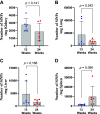Intranasal Administration of Sugarcane Ash Causes Chronic Kidney Disease in Rats
- PMID: 38234297
- PMCID: PMC11207544
- DOI: 10.1152/ajprenal.00251.2023
Intranasal Administration of Sugarcane Ash Causes Chronic Kidney Disease in Rats
Abstract
Background. Silica nanoparticles found in sugarcane ash have been postulated to be a toxicant contributing to chronic kidney disease of unknown etiology (CKDu). However, while the administration of manufactured silica nanoparticles is known to cause chronic tubulointerstitial disease in rats, the effect of administering sugarcane ash on kidney pathology remains unknown. Here we investigate whether sugarcane ash can induce CKD in rats. Methods. Sugarcane ash was administered for 13 weeks into the nares of rats (5 mg/day for 5d/week), and blood, urine and kidney tissues were collected at 13 weeks (at the end of ash administration) and in a separate group of rats at 24 weeks (11 weeks after stopping ash administration). Kidney histology was evaluated, and inflammation and fibrosis (collagen deposition) measured. Results. Sugarcane ash exposure led to the accumulation of silica in the kidneys, lungs, liver and spleen of rats. Mild proteinuria developed although renal function was largely maintained. However, biopsies showed focal glomeruli with segmental glomerulosclerosis, and tubulointerstitial inflammation and fibrosis that tended to worsen even after the ash administration had been stopped. Staining for the lysosomal marker, LAMP-1, showed decreased staining in ash administered rats consistent with lysosomal activation. Conclusion. Sugarcane ash containing silica nanoparticles can cause CKD in rats.
Keywords: Climate Change; Mesoamerican Nephropathy; Silica; chronic kidney disease.
Conflict of interest statement
C.A.R.-J., L.G.S.-L., and R.J.J. have equity with Colorado Research Partners LLC, and R.J.J. has stock with XORTX Therapeutics and has also received honoraria from Horizon Pharma and Calliditas Therapeutics. None of the other authors has any conflicts of interest, financial or otherwise, to disclose.
Figures






Similar articles
-
Modulation of the thiol redox proteome by sugarcane ash-derived silica nanoparticles: insights into chronic kidney disease of unknown etiology.Part Fibre Toxicol. 2025 Feb 6;22(1):3. doi: 10.1186/s12989-025-00619-8. Part Fibre Toxicol. 2025. PMID: 39910563 Free PMC article.
-
Inhaled silica nanoparticles cause chronic kidney disease in rats.Am J Physiol Renal Physiol. 2022 Jul 1;323(1):F48-F58. doi: 10.1152/ajprenal.00021.2022. Epub 2022 May 30. Am J Physiol Renal Physiol. 2022. PMID: 35635324 Free PMC article.
-
Sugarcane ash and sugarcane ash-derived silica nanoparticles alter cellular metabolism in human proximal tubular kidney cells.Environ Pollut. 2023 Sep 1;332:121951. doi: 10.1016/j.envpol.2023.121951. Epub 2023 Jun 8. Environ Pollut. 2023. PMID: 37301454 Free PMC article.
-
Leptospirosis Renal Disease: Emerging Culprit of Chronic Kidney Disease Unknown Etiology.Nephron. 2018;138(2):129-136. doi: 10.1159/000480691. Epub 2017 Sep 20. Nephron. 2018. PMID: 28926845 Review.
-
Distribution and Determinants of Chronic Kidney Disease of Unknown Etiology: A Brief Overview.Indian J Nephrol. 2020 Jul-Aug;30(4):241-244. doi: 10.4103/ijn.IJN_313_18. Epub 2019 Sep 9. Indian J Nephrol. 2020. PMID: 33273787 Free PMC article. Review.
Cited by
-
Health burden of sugarcane burning on agricultural workers and nearby communities.Inhal Toxicol. 2024 May;36(5):327-342. doi: 10.1080/08958378.2024.2316875. Epub 2024 Feb 13. Inhal Toxicol. 2024. PMID: 38349733 Free PMC article. Review.
-
The Promise of Metabolomics and Exposomics in CKDu.Kidney Int Rep. 2024 Mar 28;9(5):1163-1166. doi: 10.1016/j.ekir.2024.03.025. eCollection 2024 May. Kidney Int Rep. 2024. PMID: 38707828 Free PMC article. No abstract available.
-
The Adverse Health Effects of Air Pollution from Sugarcane Burning: A Scoping Review of Observational and Experimental Evidence.Environ Health Perspect. 2025 Jan;133(1):16002. doi: 10.1289/EHP14456. Epub 2025 Jan 30. Environ Health Perspect. 2025. PMID: 39883532 Free PMC article.
-
Modulation of the thiol redox proteome by sugarcane ash-derived silica nanoparticles: insights into chronic kidney disease of unknown etiology.Part Fibre Toxicol. 2025 Feb 6;22(1):3. doi: 10.1186/s12989-025-00619-8. Part Fibre Toxicol. 2025. PMID: 39910563 Free PMC article.
References
-
- Bakar RA, Yahya R, Gan SN. Production of high purity amorphous silica from rice husk. Procedia Chemistry 19: 189–195, 2016. doi:10.1016/j.proche.2016.03.092. - DOI
-
- Pode R. Potential applications of rice husk ash waste from rice husk biomass powerplant. Renew Sustain Energy Rev 53: 1468–1485, 2016. doi:10.1016/j.rser.2015.09.051. - DOI
-
- Guzmán A, Gutiérrez C, Amigó V, de Gutiérrez RM, Delvasto S. Pozzolanic evaluation of the sugar cane leaf. Mater Construct 61: 213–225, 2011. doi:10.3989/mc.2011.54809. - DOI
-
- Martín-de-Lucía I, Campos-Mañas MC, Agüera A, Rodea-Palomares I, Pulido-Reyes G, Leganés F, Fernández-Piñas F, Rosal R. Reverse Trojan-horse effect decreased wastewater toxicity in the presence of inorganic nanoparticles. Environ Sci: Nano 4: 1273–1282, 2017. doi:10.1039/C6EN00708B. - DOI
-
- Le Blond J, Woskie S, Horwell CJ, Williamson BJ. Particulate matter produced during commercial sugarcane harvesting and processing: a respiratory health hazard? Atmos Environ 149: 34–46, 2017. doi:10.1016/j.atmosenv.2016.11.012. - DOI
Grants and funding
LinkOut - more resources
Full Text Sources
Research Materials
Miscellaneous

